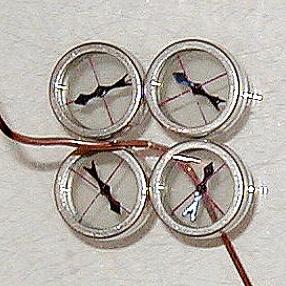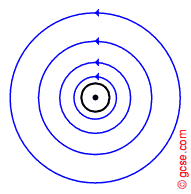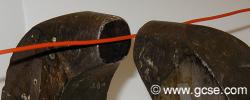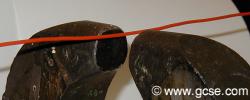The basic idea behind an electromagnet is extremely simple:Pass an electrical current through a wire and something amazing happens: a magnetic field is produced! You can show this by passing current through an insulated wire near a compass, although iron filings will also do.
Turning the current on and off will cause the compasses to deflect. Shown below are four compasses near a wire that comes towards the camera.

Magnetic Field around a straight wire
The shape of the magnetic field around a current-carrying conductor is rather curious: it is circular. The strongest deflection of compasses happens nearest to the wire.
We can draw the field as a series of concentric circles around the wire as shown below. Notice that the circles are closer together nearer the wire: this indicates a stronger field.

Rather than awkwardly draw the field in some sort of 3D image, we normally draw them as if seeing the wire from above or below, as shown here:


The animation clearly shows that reversing the direction of the current reverses the direction of the magnetic field.
The magnetic field of a long, straight current-carrying wire is stronger:
(the field becomes stronger so we would draw more lines closer together)
1.increase the size of the current
2.when a larger current flows through the wire
Field Directions
The direction of the field lines shows how a compass would line up if placed at that point. We can use the right hand grip rule to remember the relationship between current and field around a wire:

Grab the wire with your right fist (as shown), thumb pointing up: this is the direction of conventional current ( + to - ).
Your curled up fingers show the direction of the field.
An alternative way of remembering this is called the corkscrew rule: when screwing in a corkscrew to a bottle of wine, the point indicates the direction of the current, the the turning the field direction.
N.B. This does not, of course, work with left-handed corkscrews!
Magnetic field pattern around a flat coil and solenoid
When an electric current flows in a wire it creates a magnetic field around the wire.
By winding the wire into a coil we can strengthen the magnetic field. Electromagnets are made from coils like this, Making an electromagnet stronger.

A strong field can be made by coiling the wire around a piece of soft iron.
This electromagnet is sometimes called a solenoid. The shape of the magnetic field is the same as a bar magnet.

We can make an electromagnet stronger by doing these things:
* wrapping the coil around an iron core
* adding more turns to the coil
* increasing the current flowing through the coil.

Force on Current-carrying conductors
Place a current-carrying conductor in an external magnetic field (perhaps between two bar magnets), and the fields will push against each other. This force is incredibly important: it is the basis for all electric motors!

Normally the external field is fixed in place, so the force is only seen to act on the wire: moving it up or down. However, remember that forces come in pairs - the permanent magnets will experience the force too.

In the image above, the wire is at 90° to the direction of the magnetic field (which is between the poles of a horseshoe magnet).
Current is flowing to the left; the magnetic field diagonally towards us. This results in an upwards force on the wire.
If we reverse the direction of the current, the magnetic field around the wire reverses (surprise!). This reverses the force, so the wire deflects down:

A rather neat result of this effect is that if we pass alternating current (ac) through the wire, the direction of the force will continuously change. In the UK, ac is at a frequency of 50 Hz, so the wire can be seen vibrating up and down. This effect is used in speakers!
Fleming's Left Hand Rule

We have three directions to worry about: current, field and force. At GCSE we make sure the wire is held at 90° to the direction of the field. This makes life easier: the force is either up or down.
Current: dc - this is always from + to -
Field: direction is always from N to S.
Force: depends on how the other two align.
The left hand rule can be used to show how these three are related in a motor.
hate science
ReplyDelete